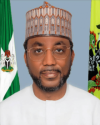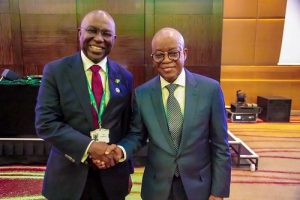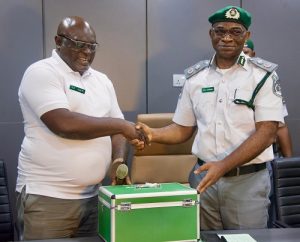Bello-Koko: Repositioning Nigerian Ports, Taking Infrastructure Rehabilitation to Global Standard

BELLO KOKO
In a bid to ensure that Nigeria attains world standard in ports efficiency and remains preferable port of choice by conference liners ever in search of a hub environment in the West and Central African sub-region, the Nigerian Ports Authority (NPA) is evolving infrastructure overhaul which aims to boost trade facilitation. In this special report, Francis Ugwoke writes on the strides in automation of services, deep seaports, port community system, substructure renewal, among others under the transformation agenda of the organization….
The task of nation building is enormous. It is also revolving as it is not limited to one. Everyone makes his or her own contribution for a common good of all. At a time of economic hard times, every strategic sector of the national economy is playing a role. The maritime sector is not left out. And this is even moreso as it is adjudged as next to oil in terms of contribution. Experts believe that the maritime sector is strategic to the turnaround of the economy with signs of poor returns from the oil sector. The expectation is that with the potentials of the blue sea economy fully harnessed, the maritime sector would be taking the position of oil in the nation’s economy. The current contribution of the industry to the country’s Gross Domestic Product (GDP) as reported by the National Bureau of Statistics (NBS) last year has remained a subject of concern. Reports had it that the sector posted 0.01 percent and 0.0 percent in the second and first quarter of last year respectively. But expert view is that the activities of the maritime sector have been grossly under reported by the NBS. The oil sector contribution to GDP is 6.63 per cent. So if the sector is next to oil, it should be seen as having a GDP contribution that is close to the above figure. Yet, the projection is not one that is so close, but in the making, all things being equal, so to say. However, indications are that with varying development agenda by different agencies of government in the sector, there is optimism on the dreams of the sector being met.
Ports Devt Agenda
As part of the efforts to increase the contribution of the maritime sector to the GDP, the NPA has been working hard to ensure that this becomes a reality. This effort has taken many fronts in what is expected to position Nigerian ports as a transshipment base as far as shipping is concerned. Efforts are targeted at transformations that will lead to efficiency in operations in addition to increased tonnage at the ports. No doubt that there are other neighbouring ports that are competing for this position over the years, the advantage for Nigeria is indeed the huge market for many conference liners. For instance, Nigeria is reputed as having more volumes of trade not just in West and Central African sub-region but also in the whole of Africa. Just like South Africa is reputed as having the largest intra- African trading nation and accounts for about 20 percent of total intra-African trade, Nigeria remains the biggest importing nation in the West and Central African sub-region. In response to the trading volume, Nigeria is investing heavily in infrastructure. This includes investment in deep seaport development as well as rehabilitation of aging infrastructure in older seaports scattered in West and Eastern parts of the country. The news about a subsidiary of MSC investing US$380 million in Lomé/Togo port to be able to handle post-Panamax vessels and therefore position the country as transshipment hub would appear to have startled Nigerian shipping stakeholders. The idea is that all cargoes handled by MSC from Asia for the West African region are first shipped to Lome from where these goods would be transshipped to other parts of the region, including Nigeria. Incidentally, Lome’s cargo volume as at 2021 was 1,986,131.000 teus yearly. This is against Nigeria’s container throughput of 1.867,409,000 teus as at December 2021.This has made the seaport very busy in the sub-region. The comparison shows that except new ideas on investment in deep seaports and infrastructure that will lift the standard of Nigerian ports, Lome seaport would move from the present rating to even higher to the detriment of Nigerian ports economically. Apart from Lome seaports with modern facilities, Tema ports in Ghana have also been upgraded by Bolloré, a French company and APM Terminals (Maersk) with investment worth US$1.5 billion to increase the ports’ capacity. Now, the port has a .4 km quay and 4 deep berths, modern gantry cranes and an efficient terminal operating systems.
Nigeria, however, is not folding her hands and watching. The country has also moved on, completing recently a US$1.5 billion port project in Lekki port. The seaport is to tackle issues of congestion that plagued the Apapa and Tin Can seaports over the years. .The Lekki deep seaport has capacity to handle bigger vessels arriving the country with 18,000 teus. But beyond the Lekki deep seaport, there are plans for other seaports which are natural seaports that will be well positioned to compete with those of the neighbouring ports. For instance, the Badagry seaport when completed will have capacity to handle any size of ship as a natural port. This is the expectation for other deep seaports that are being planned in Akwa Ibom, Cross River and Bonny in Rivers State. These are projects that are expected to boost the economic contributions of the maritime sector to the national economy. In all these projects, the NPA is expected to play prominent roles as the landlord of the system. Just recently, the Lagos Port Complex, Apapa, berthed the biggest vessel in its history. The vessel christened Kota Canik, is coming on the heels of the launch of two tug boats, M.T MAIKOKO and M.T DA-OPUKURO.
The vessel has a Length Overall LOA, of 300 metres and constructed by Damen.
The vessel has the capacity to carry 6,600 Twenty Equivalent Units TEUS during voyage. Port Manager of the LPC Charles Bamidele Okaga, told newsmen that the berthing of the vessel was part of the commitment of the management of the NPA under Mohammed Bello-Koko to sustain investment in ports infrastructure.
Okaga said NPA is deeply committed in the efforts to improve on operational excellence and efficiency. It would be recalled that Bello-Koko had recently commissioned two control towers to serve the Lagos ports.
He had promised to ensure that the nation’s ports are equipped to meet global standards.
He told newsmen, “This exceptional delivery by Apapa port coming on the heels of the reception in the month of May of MSc Maureen, a vessel with an LOA of 300m and breadth of 40m, which berthed at the Tin Can Island Port Complex in Lagos demonstrates NPA’s readiness to create and sustain improved performance across board.”
NPA’s Automation
Over the years, the NPA has automated its services, a development which gladdens the heart of stakeholders. Under this, every payment of charges/dues are settled electronically. Late last year, the Managing Director, Mohammed Bello-Koko, said the organisation was working to ensure full automation of the port system. He explained that with this, vehicular and human interface would be reduced. The authority targets 2024 for the full automation. He was quoted telling participants at a meeting of the Port Management Association of West and Central Africa (PMAWCA), held in Luanda, Angola. At another television programme, he said the organization has also engaged a consultant from the International Maritime Organisation (IMO) towards the deployment of the port community system. He disclosed that IMO was responsible for funding part of this project.
Ports Infrastructure Rehabilitation
As part of making Nigerian ports to be more efficient and to be able to compete with other world ports, the NPA is currently rehabilitating some of the dilapidated infrastructures in all the ports in the country. Among the projects include upgrading of infrastructure at terminal ‘B’, Berth 7 and 8, Onne Port Complex. It was gathered that this is an investment exceeding $110m over a period of two years. So far, the current overall progress on all ongoing works is 75% as at October last year. The organization also completed the construction of 6,000 metric tonnes bitumen tank in Rivers Port Complex. This was to improve the bitumen storage capacity to ease operations. NPA also has approval for the completion of road network for the integration of Berth 9,10, &11 at Onne Port and modernization of Control Towers at Lagos Port Complex as well as Tin Can Island Port. The organization is billed to install 180 marine fenders on all quays authority wide for safe berthing. The Authority, it was gathered, has completed consultancy services for shore protection and rehabilitation of the Escravos breakwaters. Few months ago, the organization was reviewing available funding options to be able to begin reconstruction of Tin Can Island Port Complex II, Berth 4-14 in Apapa Port Complex III. Berth 2 in Onne IV, Terminal C in Warri and Warri Jetties. Sources close to the authority said 86 buoys for Warri and Calabar Pilotage Districts have been installed. Similarly, there have been survey and installation of buoys at Ijegun/Kirikiri water channel, licensing and upgrading of pilots across the four Pilotage District; acquisition of Harbour Crafts (Tugboats, Pilot Cutters, and Patrol Boats; licensing of additional 4 truck parks to increase capacity of truck parks servicing the Lagos Ports;
Other development projects carried out by Bello-Koko-led administration include licensing of 10 Export Processing Terminals to facilitate exports at Nigerian Sea Ports (Four of these terminals are already fully Operational); Complete Dry-docking of some Tug Boats in order to increase the Authority’s fleet; 65% reduction in number of accidents recorded, arising from improved standard of trucks operating within the port premises; Procurement and deployment of 6 security patrol boats (SPBs) to all Pilotage Districts in order to check incessant attacks of vessels along the channels and at ports’ waterfronts.
Lagos Control Towers
As part of the efforts to improve on operational efficiency at the ports, the NPA recently commissioned control towers at the Lagos ports. The control towers will serve both Tin Can and Apapa ports.
Bello-Koko disclosed during the ceremony in Lagos that it was part of the determination by the organization to improve on the efficiency of the nation’s ports.
He explained that the control towers will among others assist in improving vessel traffic management, navigation assistance, advance visibility, safety and security, emergency response, communication, resource management and disaster risk mitigation..
According to him, “The commissioning of control tower signposts our unwavering commitment towards improving operational efficiency through aggressive infrastructure and equipment renewal.
“As most of us are aware, safety and security constitute critical operational preconditions necessary for the actualization of our strategic intent of becoming the maritime logistics hub for sustainable port services in Africa, which is why we placed high priority on putting in place a modern control tower of this nature in order enhance our domain awareness capability.
“Given the decrepit and non-functional state we met this facility, the decision to invest so much towards making it the state-of-the-art and well equipped edifice was made taking cognizance of the need to equip our highly cherished and well trained marine talents with the right tools and comfort required to deliver efficient services to our stakeholders.
“Sustainably providing efficient port service in safe, secure, and customer friendly environment requires that we ensure and assure that we are up to date in terms of skill and equipment, and I will like to assure that beyond this commissioning today, we are resolved to continually equip and re-equip this facility whilst training and re-training its users to be best-in-class.”
The NPA is in partnership with the Nigerian Navy to have the “signal stations rehabilitated, re-equipped and located near the naval base for improved communication”, Bello-Koko disclosed.
Plugging Revenue Leakages
The NPA has witnessed a robust revenue increase since the appointment of Bello-Koko. Early this, year, the authority announced revenue increase from N317 billion in 2020 to N361 billion in 2022. The remittances to the Consolidated Revenue Account (CRA) of the organization also increased from N80 billion to N91 billion in about a year as at March this year. Many industry stakeholders have applauded the leadership of the agency for this. Even the former Minister of Transportation, Alhaji Mu’azu Sambo was not left out. Sambo had during a visit to the authority last year said he was impressed by the increase in NPA’s revenue generation and remittance. The Minister also expressed satisfaction that the management team of the agency has been impacting positively on the nation’s maritime sector.
He told Bello-Koko: “MD NPA, I must state that Council (FEC) is happy with you and your team. I commend you and your Management team for your efforts in moving the nation forward especially the increase in revenue generation to government coffers. You have done well.”
Apparently impressed about the performance of the agency Sambo also early this year pledged government’s support to improve on the welfare of the staff.
In addition to improving revenue generation, the NPA management has also created opportunities for jobs. This is through barge operations which will be involved in moving some cargoes from the ports so that it is not just by road. This is moreso as it affects Lekki Deep Seaport. It is estimated that at least N2bn can be generated annually by barge operators in what is expected to lead to more employment. The NPA also introduced a policy of licensing additional truck parks to take care of Lagos ports and address traffic issues.
The task of nation building is enormous. It is also revolving as it is not limited to one. Everyone makes his or her own contribution for a common good of all. At a time of economic hard times, every strategic sector of the national economy is playing a role. The maritime sector is not left out. And this is even moreso as it is adjudged as next to oil in terms of contribution. Experts believe that the maritime sector is strategic to the turnaround of the economy with signs of poor returns from the oil sector. The expectation is that with the potentials of the blue sea economy fully harnessed, the maritime sector would be taking the position of oil in the nation’s economy. The current contribution of the industry to the country’s Gross Domestic Product (GDP) as reported by the National Bureau of Statistics (NBS) last year has remained a subject of concern. Reports had it that the sector posted 0.01 percent and 0.0 percent in the second and first quarter of last year respectively. But expert view is that the activities of the maritime sector have been grossly under reported by the NBS. The oil sector contribution to GDP is 6.63 per cent. So if the sector is next to oil, it should be seen as having a GDP contribution that is close to the above figure. Yet, the projection is not one that is so close, but in the making, all things being equal, so to say. However, indications are that with varying development agenda by different agencies of government in the sector, there is optimism on the dreams of the sector being met.
Ports Devt Agenda
As part of the efforts to increase the contribution of the maritime sector to the GDP, the NPA has been working hard to ensure that this becomes a reality. This effort has taken many fronts in what is expected to position Nigerian ports as a transshipment base as far as shipping is concerned. Efforts are targeted at transformations that will lead to efficiency in operations in addition to increased tonnage at the ports. No doubt that there are other neighbouring ports that are competing for this position over the years, the advantage for Nigeria is indeed the huge market for many conference liners. For instance, Nigeria is reputed as having more volumes of trade not just in West and Central African sub-region but also in the whole of Africa. Just like South Africa is reputed as having the largest intra- African trading nation and accounts for about 20 percent of total intra-African trade, Nigeria remains the biggest importing nation in the West and Central African sub-region. In response to the trading volume, Nigeria is investing heavily in infrastructure. This includes investment in deep seaport development as well as rehabilitation of aging infrastructure in older seaports scattered in West and Eastern parts of the country. The news about a subsidiary of MSC investing US$380 million in Lomé/Togo port to be able to handle post-Panamax vessels and therefore position the country as transshipment hub would appear to have startled Nigerian shipping stakeholders. The idea is that all cargoes handled by MSC from Asia for the West African region are first shipped to Lome from where these goods would be transshipped to other parts of the region, including Nigeria. Incidentally, Lome’s cargo volume as at 2021 was 1,986,131.000 teus yearly. This is against Nigeria’s container throughput of 1.867,409,000 teus as at December 2021.This has made the seaport very busy in the sub-region. The comparison shows that except new ideas on investment in deep seaports and infrastructure that will lift the standard of Nigerian ports, Lome seaport would move from the present rating to even higher to the detriment of Nigerian ports economically. Apart from Lome seaports with modern facilities, Tema ports in Ghana have also been upgraded by Bolloré, a French company and APM Terminals (Maersk) with investment worth US$1.5 billion to increase the ports’ capacity. Now, the port has a .4 km quay and 4 deep berths, modern gantry cranes and an efficient terminal operating systems.
Nigeria, however, is not folding her hands and watching. The country has also moved on, completing recently a US$1.5 billion port project in Lekki port. The seaport is to tackle issues of congestion that plagued the Apapa and Tin Can seaports over the years. .The Lekki deep seaport has capacity to handle bigger vessels arriving the country with 18,000 teus. But beyond the Lekki deep seaport, there are plans for other seaports which are natural seaports that will be well positioned to compete with those of the neighbouring ports. For instance, the Badagry seaport when completed will have capacity to handle any size of ship as a natural port. This is the expectation for other deep seaports that are being planned in Akwa Ibom, Cross River and Bonny in Rivers State. These are projects that are expected to boost the economic contributions of the maritime sector to the national economy. In all these projects, the NPA is expected to play prominent roles as the landlord of the system. Just recently, the Lagos Port Complex, Apapa, berthed the biggest vessel in its history. The vessel christened Kota Canik, is coming on the heels of the launch of two tug boats, M.T MAIKOKO and M.T DA-OPUKURO.
The vessel has a Length Overall LOA, of 300 metres and constructed by Damen.
The vessel has the capacity to carry 6,600 Twenty Equivalent Units TEUS during voyage. Port Manager of the LPC Charles Bamidele Okaga, told newsmen that the berthing of the vessel was part of the commitment of the management of the NPA under Mohammed Bello-Koko to sustain investment in ports infrastructure.
Okaga said NPA is deeply committed in the efforts to improve on operational excellence and efficiency. It would be recalled that Bello-Koko had recently commissioned two control towers to serve the Lagos ports.
He had promised to ensure that the nation’s ports are equipped to meet global standards.
He told newsmen, “This exceptional delivery by Apapa port coming on the heels of the reception in the month of May of MSc Maureen, a vessel with an LOA of 300m and breadth of 40m, which berthed at the Tin Can Island Port Complex in Lagos demonstrates NPA’s readiness to create and sustain improved performance across board.”
NPA’s Automation
Over the years, the NPA has automated its services, a development which gladdens the heart of stakeholders. Under this, every payment of charges/dues are settled electronically. Late last year, the Managing Director, Mohammed Bello-Koko, said the organisation was working to ensure full automation of the port system. He explained that with this, vehicular and human interface would be reduced. The authority targets 2024 for the full automation. He was quoted telling participants at a meeting of the Port Management Association of West and Central Africa (PMAWCA), held in Luanda, Angola. At another television programme, he said the organization has also engaged a consultant from the International Maritime Organisation (IMO) towards the deployment of the port community system. He disclosed that IMO was responsible for funding part of this project.
Ports Infrastructure Rehabilitation
As part of making Nigerian ports to be more efficient and to be able to compete with other world ports, the NPA is currently rehabilitating some of the dilapidated infrastructures in all the ports in the country. Among the projects include upgrading of infrastructure at terminal ‘B’, Berth 7 and 8, Onne Port Complex. It was gathered that this is an investment exceeding $110m over a period of two years. So far, the current overall progress on all ongoing works is 75% as at October last year. The organization also completed the construction of 6,000 metric tonnes bitumen tank in Rivers Port Complex. This was to improve the bitumen storage capacity to ease operations. NPA also has approval for the completion of road network for the integration of Berth 9,10, &11 at Onne Port and modernization of Control Towers at Lagos Port Complex as well as Tin Can Island Port. The organization is billed to install 180 marine fenders on all quays authority wide for safe berthing. The Authority, it was gathered, has completed consultancy services for shore protection and rehabilitation of the Escravos breakwaters. Few months ago, the organization was reviewing available funding options to be able to begin reconstruction of Tin Can Island Port Complex II, Berth 4-14 in Apapa Port Complex III. Berth 2 in Onne IV, Terminal C in Warri and Warri Jetties. Sources close to the authority said 86 buoys for Warri and Calabar Pilotage Districts have been installed. Similarly, there have been survey and installation of buoys at Ijegun/Kirikiri water channel, licensing and upgrading of pilots across the four Pilotage District; acquisition of Harbour Crafts (Tugboats, Pilot Cutters, and Patrol Boats; licensing of additional 4 truck parks to increase capacity of truck parks servicing the Lagos Ports;
Other development projects carried out by Bello-Koko-led administration include licensing of 10 Export Processing Terminals to facilitate exports at Nigerian Sea Ports (Four of these terminals are already fully Operational); Complete Dry-docking of some Tug Boats in order to increase the Authority’s fleet; 65% reduction in number of accidents recorded, arising from improved standard of trucks operating within the port premises; Procurement and deployment of 6 security patrol boats (SPBs) to all Pilotage Districts in order to check incessant attacks of vessels along the channels and at ports’ waterfronts.
Lagos Control Towers
As part of the efforts to improve on operational efficiency at the ports, the NPA recently commissioned control towers at the Lagos ports. The control towers will serve both Tin Can and Apapa ports.
Bello-Koko disclosed during the ceremony in Lagos that it was part of the determination by the organization to improve on the efficiency of the nation’s ports.
He explained that the control towers will among others assist in improving vessel traffic management, navigation assistance, advance visibility, safety and security, emergency response, communication, resource management and disaster risk mitigation..
According to him, “The commissioning of control tower signposts our unwavering commitment towards improving operational efficiency through aggressive infrastructure and equipment renewal.
“As most of us are aware, safety and security constitute critical operational preconditions necessary for the actualization of our strategic intent of becoming the maritime logistics hub for sustainable port services in Africa, which is why we placed high priority on putting in place a modern control tower of this nature in order enhance our domain awareness capability.
“Given the decrepit and non-functional state we met this facility, the decision to invest so much towards making it the state-of-the-art and well equipped edifice was made taking cognizance of the need to equip our highly cherished and well trained marine talents with the right tools and comfort required to deliver efficient services to our stakeholders.
“Sustainably providing efficient port service in safe, secure, and customer friendly environment requires that we ensure and assure that we are up to date in terms of skill and equipment, and I will like to assure that beyond this commissioning today, we are resolved to continually equip and re-equip this facility whilst training and re-training its users to be best-in-class.”
The NPA is in partnership with the Nigerian Navy to have the “signal stations rehabilitated, re-equipped and located near the naval base for improved communication”, Bello-Koko disclosed.
Plugging Revenue Leakages
The NPA has witnessed a robust revenue increase since the appointment of Bello-Koko. Early this, year, the authority announced revenue increase from N317 billion in 2020 to N361 billion in 2022. The remittances to the Consolidated Revenue Account (CRA) of the organization also increased from N80 billion to N91 billion in about a year as at March this year. Many industry stakeholders have applauded the leadership of the agency for this. Even the former Minister of Transportation, Alhaji Mu’azu Sambo was not left out. Sambo had during a visit to the authority last year said he was impressed by the increase in NPA’s revenue generation and remittance. The Minister also expressed satisfaction that the management team of the agency has been impacting positively on the nation’s maritime sector.
He told Bello-Koko: “MD NPA, I must state that Council (FEC) is happy with you and your team. I commend you and your Management team for your efforts in moving the nation forward especially the increase in revenue generation to government coffers. You have done well.”
Apparently impressed about the performance of the agency Sambo also early this year pledged government’s support to improve on the welfare of the staff.
In addition to improving revenue generation, the NPA management has also created opportunities for jobs. This is through barge operations which will be involved in moving some cargoes from the ports so that it is not just by road. This is moreso as it affects Lekki Deep Seaport. It is estimated that at least N2bn can be generated annually by barge operators in what is expected to lead to more employment. The NPA also introduced a policy of licensing additional truck parks to take care of Lagos ports and address traffic issues.





